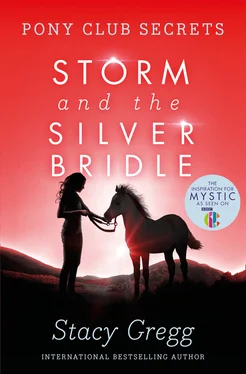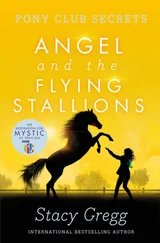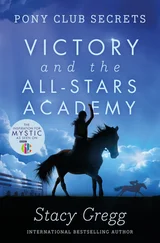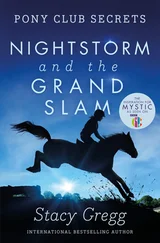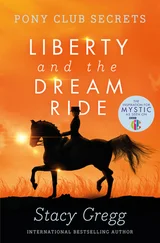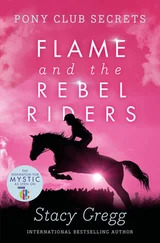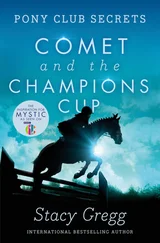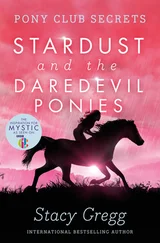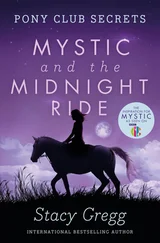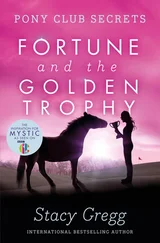
Storm and the
Silver Bridle
STACY GREGG

www.stacygregg.co.uk
First published in Great Britain by HarperCollins Children’s Books in 2009. HarperCollins Children’s Books is a division of HarperCollins Publishers Ltd, HarperCollins Publishers 1 London Bridge Street London SE1 9GF
Text copyright © Stacy Gregg 2009
Illustrations © Fiona Land 2009
Cover design copyright © HarperCollins Publishers Ltd 2020 Cover photography © Shutterstock.comCBBC logo © British Broadcasting Corporation 2016
The author and illustrator assert the moral right to be identified as the author and illustrator of the work.
All rights reserved under International and Pan-American Copyright Conventions. By payment of the required fees, you have been granted the non-exclusive, non-transferable right to access and read the text of this e-book on-screen. No part of this text may be reproduced, transmitted, down-loaded, decompiled, reverse engineered, or stored in or introduced into any information storage and retrieval system, in any form or by any means, whether electronic or mechanical, now known or hereinafter invented, without the express written permission of HarperCollins e-books.
Ebook Edition © 2009 ISBN: 9780007340705
Version 2020-08-18
For my dad, thanks for buying me a pony
Cover
Title Page Storm and the Silver Bridle STACY GREGG
Copyright www.stacygregg.co.uk First published in Great Britain by HarperCollins Children’s Books in 2009. HarperCollins Children’s Books is a division of HarperCollins Publishers Ltd, HarperCollins Publishers 1 London Bridge Street London SE1 9GF Text copyright © Stacy Gregg 2009 Illustrations © Fiona Land 2009 Cover design copyright © HarperCollins Publishers Ltd 2020 Cover photography © Shutterstock.com CBBC logo © British Broadcasting Corporation 2016 The author and illustrator assert the moral right to be identified as the author and illustrator of the work. All rights reserved under International and Pan-American Copyright Conventions. By payment of the required fees, you have been granted the non-exclusive, non-transferable right to access and read the text of this e-book on-screen. No part of this text may be reproduced, transmitted, down-loaded, decompiled, reverse engineered, or stored in or introduced into any information storage and retrieval system, in any form or by any means, whether electronic or mechanical, now known or hereinafter invented, without the express written permission of HarperCollins e-books. Ebook Edition © 2009 ISBN: 9780007340705 Version 2020-08-18
Dedication For my dad, thanks for buying me a pony
Map
Chapter 1
Chapter 2
Chapter 3
Chapter 4
Chapter 5
Chapter 6
Chapter 7
Chapter 8
Chapter 9
Chapter 10
Chapter 11
Chapter 12
Chapter 13
Chapter 14
Chapter 15
Chapter 16
Chapter 17
The Pony Club Secrets series
About the Publisher
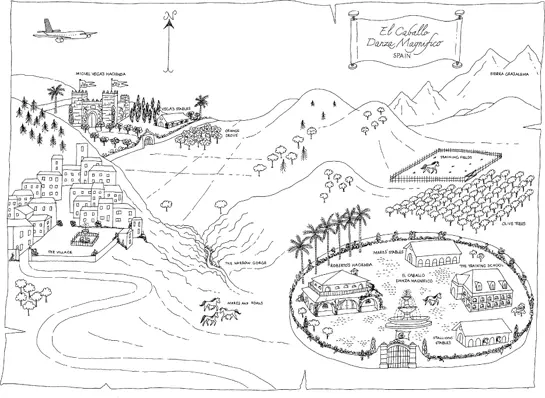
Anyone who knows anything about horses will tell you that there is no such thing as a white horse. A horse is never called ‘white’. They are always referred to as grey.
Roberto Nunez shook his head and smiled at this. How silly these rules were!
He knew that horses could not be white. Yet how else could he describe the mares that were galloping towards him? These mares were as pure white as the snow that topped the distant mountains of the Sierra de Grazalema. They were as white as the stone walls that ran around the stables here at El Caballo Danza Magnifico.
Roberto Nunez’s purebred Lipizzaner mares were as white as any animal in nature could possibly be. Their colour appeared all the more startling because it was in stark contrast with the coal-black foals that ran alongside them at their feet.
Although Lipizzaner horses are famous for being white, their foals are always born pitch-black. Gradually, as the foals grow up, their colour will change. As they mature, the Lipizzaners’ dark coat will begin to prick here and there with tiny white hairs so that by the time the foals have grown into yearlings they have become steel-grey. At the age of three Lipizzaners are almost grown-up, and their coats have become even lighter, with dapples beginning to show through the dark steel on their hindquarters. In this way, their coats will keep fading until finally, at around the age of twelve, their dapples will have washed away and the Lipizzaner will be utterly and completely snow-white just like their mothers and fathers before them.
This was the way with the Lipizzaner. Roberto Nunez knew the breed well. At his hacienda , his grand estate here in southern Spain, he bred Andalusians and Lipizzaners, along with the highly strung, elegant, chestnut Anglo-Arabs that made up his internationally renowned troupe of performing horses known as El Caballo Danza Magnifico.
The mares that were galloping towards him now, driven carefully by his men, were part of his breeding herd. They had been grazing for the day out on the dry rocky hillsides that surrounded his horse stud. Nunez liked to let the mares and their young foals roam free as much as possible. It toughened them up. It gave them spirit. But always he kept a close eye on his horses. Now, as night fell, he was bringing them home.
There were about two dozen mares in this herd, all ghostly pale, with the bloom of their grey dapples fading on their rumps. Their manes and tails were hogged off—cropped short, in the style that the Spanish always kept their breeding herds. It was funny, Nunez thought, how his mares were the ones who had their hair cropped short while the stallions, the male horses of the herd, were allowed to keep their long and silky manes.
Even without their manes, these mares were great beauties. To anyone else, they would have appeared almost identical, and yet Nunez could tell them apart at a glance. He simply looked at their faces and knew them instantly, in the same way that you and I might know a friend’s face if we saw her in a crowded street.
For instance, one mare might have a Roman nose, a noble trait often seen in the Lipizzaner, while another mare would possess the dished face of the Arabian bloodlines that had also influenced this mighty breed. Some mares had the typical Lipizzaner characteristic of perfect almond-shaped eyes. Others were blessed with a smattering of the dainty freckles known as ‘flea-bites’ flecked on their cheeks.
These were Roberto Nunez’s very best mares and they had been bred with the very best of El Caballo Danza Magnifico’s stallions.
Roberto Nunez smiled now as he caught sight of one of his favourite mares, Margarita, with her pretty coal-dark eyes and her features so delicate she looked as if she might have been carved out of marble. At Margarita’s feet was a jet-black foal. The foal was all legs, gangly and awkward, and only a few weeks old. And yet already Roberto Nunez could see the signs of greatness in him that came from being sired by one of the finest stallions in Spain.
Читать дальше
